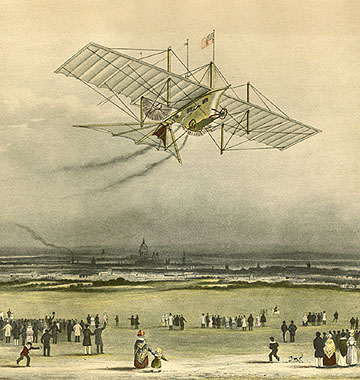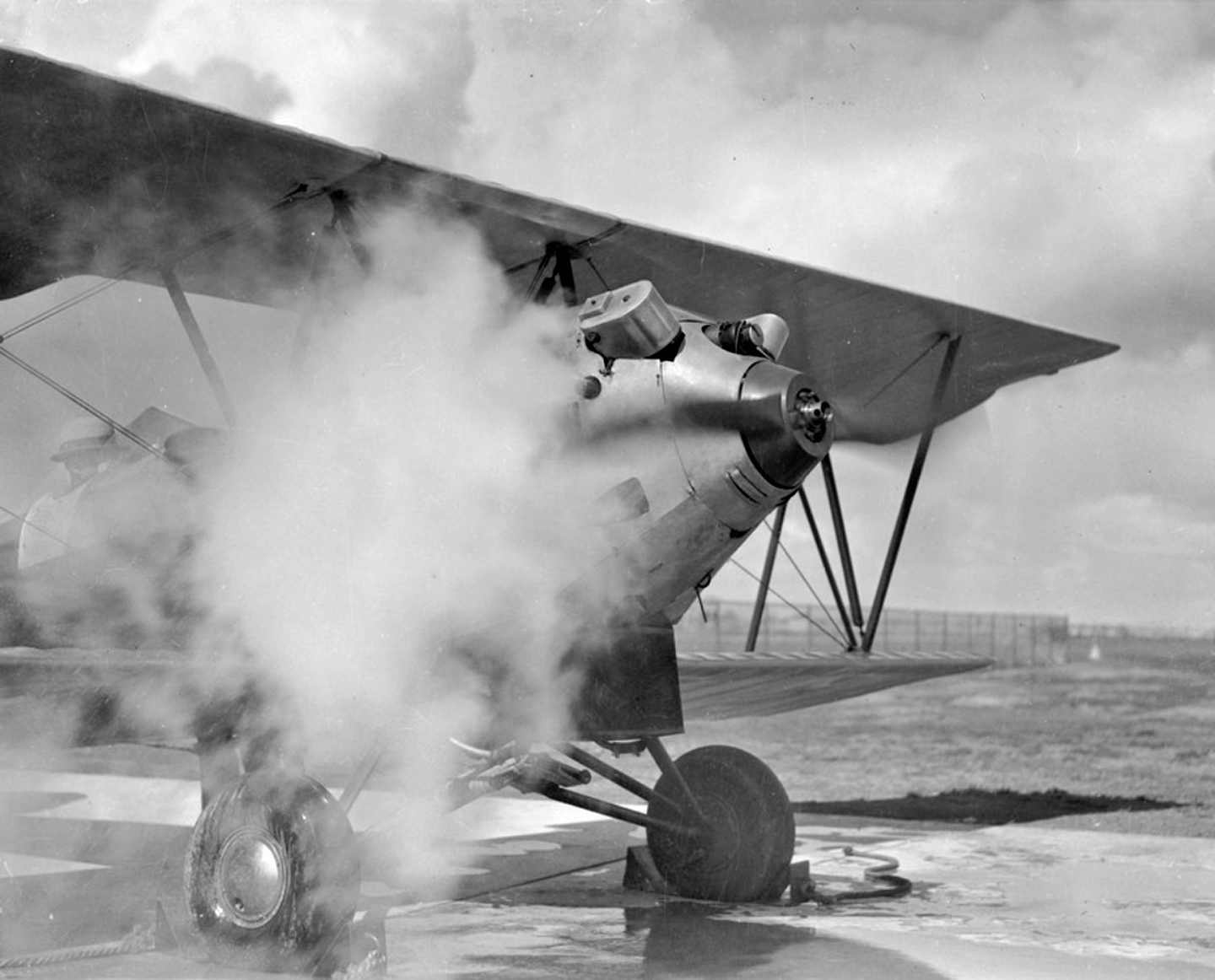Steam aircraft on:
[Wikipedia]
[Google]
[Amazon]
 A steam-powered aircraft is an
A steam-powered aircraft is an
 * 1933: George D. Besler and William J. Besler's prototype steam
* 1933: George D. Besler and William J. Besler's prototype steam
Report on the Besler aircraft
Besler Corporation Promo Film: Steam-Driven Vehicles
"Steam Takes Wings", December 1932, Popular Science
Aircraft engines
 A steam-powered aircraft is an
A steam-powered aircraft is an aircraft
An aircraft ( aircraft) is a vehicle that is able to flight, fly by gaining support from the Atmosphere of Earth, air. It counters the force of gravity by using either Buoyancy, static lift or the Lift (force), dynamic lift of an airfoil, or, i ...
propelled by a steam engine
A steam engine is a heat engine that performs Work (physics), mechanical work using steam as its working fluid. The steam engine uses the force produced by steam pressure to push a piston back and forth inside a Cylinder (locomotive), cyl ...
. Steam power was used during the 19th century, but fell into disuse with the arrival of the more practical internal combustion engine
An internal combustion engine (ICE or IC engine) is a heat engine in which the combustion of a fuel occurs with an oxidizer (usually air) in a combustion chamber that is an integral part of the working fluid flow circuit. In an internal comb ...
at the beginning of the pioneer era.
Steam power is distinct from its use as a lifting gas in thermal airships and early balloons.
History
* 1842: The Aerial Steam Carriage of William Samuel Henson and John Stringfellow was patented, but was never successful, although a steam-powered model was flown in 1848. * 1852: Henri Giffard flew a 3-horsepower (2 kW) steam-powereddirigible
An airship, dirigible balloon or dirigible is a type of aerostat ( lighter-than-air) aircraft that can navigate through the air flying under its own power. Aerostats use buoyancy from a lifting gas that is less dense than the surrounding ...
over Paris; it was the first powered aircraft.
* 1861 Gustave Ponton d'Amécourt made a small steam-powered craft, coining the name helicopter
A helicopter is a type of rotorcraft in which Lift (force), lift and thrust are supplied by horizontally spinning Helicopter rotor, rotors. This allows the helicopter to VTOL, take off and land vertically, to hover (helicopter), hover, and ...
.
* 1874: Félix du Temple flew a steam-powered aluminium monoplane
A monoplane is a fixed-wing aircraft configuration with a single mainplane, in contrast to a biplane or other types of multiplanes, which have multiple wings.
A monoplane has inherently the highest efficiency and lowest drag of any wing con ...
off a downhill run. While it did not achieve level flight, it was the first manned heavier-than-air powered flight.
* 1877: Enrico Forlanini built and flew a model steam-powered helicopter in Milan
Milan ( , , ; ) is a city in northern Italy, regional capital of Lombardy, the largest city in Italy by urban area and the List of cities in Italy, second-most-populous city proper in Italy after Rome. The city proper has a population of nea ...
.
* 1882: Alexander Mozhaisky built a steam-powered plane but it did not achieve sustained flight. The engine from the plane is in the Central Air Force Museum
The Central Air Force Museum () is an aviation museum in Monino, Moscow Oblast, Russia. A branch of the Central Armed Forces Museum, it is one of the world's largest aviation museums, and the largest for Soviet aircraft, with a collection includi ...
in Monino, Moscow.
* 1890: Clément Ader built a steam-powered, bat-winged monoplane
A monoplane is a fixed-wing aircraft configuration with a single mainplane, in contrast to a biplane or other types of multiplanes, which have multiple wings.
A monoplane has inherently the highest efficiency and lowest drag of any wing con ...
, named the Eole. Ader flew it on October 9, 1890, over a distance of , but the engine was inadequate for sustained and controlled flight. His flight did prove that a heavier-than-air flight was possible. Ader made at least three further attempts, the last two on 12 and 14 October 1897 for the French Ministry of War. There is controversy about whether or not he attained controlled flight. Ader did not obtain funding for his project, and that points to its probable failure.
* 1894: Sir Hiram Stevens Maxim (inventor of the Maxim Gun) built and tested a large rail-mounted, steam-powered aircraft testbed, with a mass of and a wingspan of in order to measure the lift produced by different wing configurations. The machine unexpectedly generated sufficient lift and thrust to break free of the test track and fly, but was never intended to be operated as a piloted aircraft and so crashed almost immediately owing to its lack of flight controls.
* 1896: Samuel Pierpont Langley successfully flew unpiloted steam-powered models.
*1897: Carl Richard Nyberg's Flugan
Flugan (''The Fly'') was an early aeroplane designed and built by Carl Richard Nyberg outside his home in Lidingö, Sweden. Construction started in 1897 and he kept working on it until 1922. The craft only managed a few short jumps and Nyberg w ...
developed steam-powered aircraft over a period from 1897 to 1922, but they never achieved more than a few short hops.
* 1899: Gustave Whitehead built, and was purported to have flown, a steam-powered airplane in Pittsburgh, Pennsylvania. Stoker/passenger Louis Darvarich was said to have been injured when the plane crashed into an upper story of an apartment building. Whitehead later claimed to have flown a steam aircraft in Hartford, Connecticut, and to have been visited by one of the Wright brothers well before 1903. Mainstream aviation historians remain unconvinced of the Whitehead claims. The flights have never been verified satisfactorily; there are no photographs, news stories, or other media from 1899 to confirm them. Likewise, the supposed visit of the Wright brothers to Whitehead is apocryphal; other than affidavits taken over thirty years after the fact, there is no evidence the visit ever happened.
* 1902 Lyman Gilmore claimed in 1927 to have flown a steam-powered aircraft on 15 May 1902. The flight was unconfirmed.
* 1920: The Bristol Tramp was to have been a steam-powered aeroplane, but the turbine was over-powered, and the construction of a reliable boiler and condenser circuit was problematic.
* 1931 Harry Crossland Pfaff of Chicago designed and made a steam-powered aircraft. It was to be test flown by round-the-world aviator Clyde Pangborn. There is no record of the flight being made.  * 1933: George D. Besler and William J. Besler's prototype steam
* 1933: George D. Besler and William J. Besler's prototype steam biplane
A biplane is a fixed-wing aircraft with two main wings stacked one above the other. The first powered, controlled aeroplane to fly, the Wright Flyer, used a biplane wing arrangement, as did many aircraft in the early years of aviation. While ...
, based on a Travel Air 2000
The Travel Air 2000 is an open-cockpit biplane aircraft produced in the United States in the late 1920s by the Travel Air, Travel Air Manufacturing Company. During the period from 1924–1929, Travel Air produced more aircraft than any othe ...
, flew several times at Oakland
Oakland is a city in the East Bay region of the San Francisco Bay Area in the U.S. state of California. It is the county seat and most populous city in Alameda County, with a population of 440,646 in 2020. A major West Coast port, Oakland is ...
airport. It was powered by a two-cylinder, double-expansion V-twin reciprocating engine weighing about , designed by the Doble Steam Motors Company and Besler. and was capable of STOL
A short takeoff and landing (STOL) aircraft is a fixed-wing aircraft that can takeoff/land on short runways. Many STOL-designed aircraft can operate on airstrips with harsh conditions (such as high altitude or ice). STOL aircraft, including tho ...
operation due to the ease of reversing the thrust. Several others were working on steam-powered flight at the time. Harold C. Johnson of Akron, Ohio, had made a steam engine for an aircraft in autumn 1932. The Great Lakes Aircraft Company
Great Lakes Aircraft Company is an aircraft manufacturer known for the 2T-1A Sport Trainer biplane. The company has a long history of building both private and military aircraft.
Origins
In 1929, the Great Lakes Aircraft Company (GLAC) was for ...
of Cleveland, Ohio, was working on a steam-powered biplane. A Paris mechanic developed a light steam-powered engine for aircraft. Swedish steam turbine
A steam turbine or steam turbine engine is a machine or heat engine that extracts thermal energy from pressurized steam and uses it to do mechanical work utilising a rotating output shaft. Its modern manifestation was invented by Sir Charles Par ...
engineers were working on an aircraft engine, and G. A. Raffaelli, an Italian aeronautical engineer, published a paper in 1931 on a steam-powered engine for stratospheric flight .
* 1934: Newspapers of the time reported a steam-powered aircraft designed by a Mr Huettner, Chief Engineer of the Klingenberg Electric Works in Berlin, that used revolving boiler combined with a steam turbine. The plane was reported to have a design speed of and be capable of 60 to 70 hours non-stop flight. The Berlin reporter of the Czechoslovak '' Prager Tagblatt'', who wrote the article, was arrested, and no more was heard of the project.
* 1938: A British company, Aero Turbines Limited, designed a steam turbine engine similar to Huettner's. The company ceased to exist in 1948.
* 1944: A steam-powered version of the Messerschmitt Me 264, an '' Amerika Bomber'' was hypothesized but never constructed. It was to be powered by a steam turbine developing over while driving a -diameter propeller. The fuel would have been a mixture of powdered coal and petroleum
Petroleum, also known as crude oil or simply oil, is a naturally occurring, yellowish-black liquid chemical mixture found in geological formations, consisting mainly of hydrocarbons. The term ''petroleum'' refers both to naturally occurring un ...
. It seems that the steam turbines would have had an SFC of 190 gr/hp/hr. The main advantages of this powerplant were considered to be that it produced consistent power at all altitudes and required low maintenance.
* 1960s: Conceptual drawings were made for Don Johnson of Thermodynamic Systems Inc., Newport Beach, California, of a steam engine to be installed in a Hughes 300 helicopter. The steam engine was a compact cylindrical double-acting uniflow (similar in layout to the Dyna-Cam Aero engine), but no prototype was ever made by Controlled Steam Dynamics, Inc.Steamed Up Over Chopper Power, Air Progress July, 1969
Notes
References
* ''The Lore of Flight,'' 1986, The First Powered Hops, Historical Section, pg 38. Taylor, John William Ransom d. Crescent Books, New York * ''Air Progress'' magazine, July 1969; Aeronews, p. 20 ''Steamed Up Over Chopper Power'' * ''Daily Pilot,'' Thursday October 9, 1969 pg. 3 ''Speedy Steam Engine'' by Arthur R. VinselExternal links
{{Commons category, Aircraft with steam enginesReport on the Besler aircraft
Besler Corporation Promo Film: Steam-Driven Vehicles
"Steam Takes Wings", December 1932, Popular Science
Aircraft engines